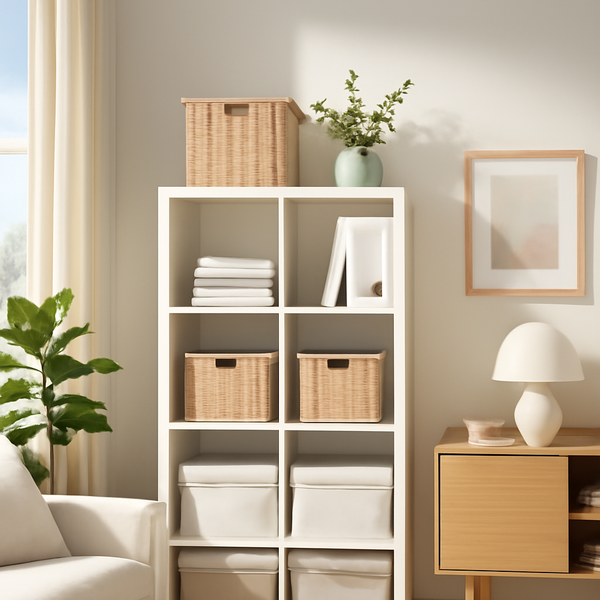
Tired of clutter taking over your home? Mastering home organization can feel overwhelming, but with the right approach, you can create a serene and functional living space. This guide will equip you with practical strategies and creative ideas to declutter, categorize, and maintain an organized home. Get ready to reclaim your space and enjoy a more peaceful environment!
Decluttering Strategies for a Fresh Start
The first step to any successful home organization project is effective decluttering. Start by dedicating specific time slots to tackle one area at a time – perhaps a single drawer, a shelf, or a small closet. Avoid the temptation to do everything at once, as this can lead to burnout and discouragement. As you go through your belongings, adopt a 'keep, donate, discard' system. For items you're unsure about, create a temporary 'maybe' box and revisit its contents after a month. If you haven't needed or thought about those items, it's likely time to let them go. Consider the 'one in, one out' rule for new purchases to prevent future clutter buildup. Regularly schedule decluttering sessions, even just for 15-30 minutes a week, to maintain momentum and keep your home tidy. This proactive approach is key to long-term organization and a more serene living environment. Remember, decluttering isn't just about physical space; it's also about mental clarity and reducing stress associated with a messy environment.
Smart Storage Solutions for Every Room
Once you've decluttered, the next crucial phase is implementing smart storage solutions tailored to your needs. Think vertically! Utilize wall space with shelves, wall-mounted organizers, and pegboards, especially in smaller rooms or tight spaces like kitchens and bathrooms. For clothing, invest in good quality hangers and consider drawer dividers to keep items separated and easily accessible. Under-bed storage containers are excellent for seasonal clothing or extra bedding. In the kitchen, stackable containers for pantry items and drawer organizers for utensils can make a huge difference. For offices and craft areas, label everything! Clear bins and containers are invaluable for seeing contents at a glance, saving you time and frustration. Don't forget about multi-functional furniture, like ottomans with hidden storage or coffee tables with drawers. These pieces not only provide extra space but also serve a primary purpose, optimizing your living area. When choosing storage, prioritize durability and aesthetics to ensure your solutions are both practical and pleasing to the eye.
Categorizing and Labeling for Optimal Access
Effective organization hinges on smart categorization and clear labeling. Group similar items together. For instance, all cleaning supplies should be in one designated area, cooking utensils in another, and office supplies in their respective zone. This makes finding what you need intuitive and quick. Once items are categorized, labeling becomes your best friend. Use clear, legible labels on bins, boxes, and shelves. This is especially helpful in areas like the pantry, linen closet, or garage where you might have many similar-looking items. You can use a label maker, simple stickers, or even handwritten tags. For clothing, consider categorizing by type (shirts, pants, sweaters) or season within your closets. For documents and paperwork, implement a filing system that works for you, whether it's by client, project, or date. Consistent labeling ensures that everyone in the household knows where things belong, making the tidying process much smoother and reducing the chances of items being misplaced. This systematic approach transforms chaos into order.
Maintaining Organization: Habits and Routines
Achieving an organized home is one thing, but maintaining it is the ongoing challenge. The key to long-term success lies in establishing simple, consistent habits and routines. Dedicate a few minutes each day to put items back in their designated places. This could be before bed, after meals, or whenever you notice something out of order. Implement a weekly reset – perhaps an hour on the weekend to tidy up common areas, restock supplies, and quickly declutter any new accumulation. Put mail and papers away immediately, rather than letting them pile up. Tackle small messes as they happen; a quick wipe-down of the counter is much easier than scrubbing dried-on grime later. Regularly review your storage systems and declutter as needed, perhaps seasonally. Involve all household members in the process by assigning age-appropriate chores or responsibilities. Creating a habit of putting things away immediately after use is perhaps the most powerful tool in maintaining an organized home and preventing future clutter.
The Psychological Benefits of an Organized Home
Beyond the aesthetic appeal, a well-organized home offers significant psychological benefits. Living in a clutter-free environment can dramatically reduce stress and anxiety levels. When your physical space is orderly, your mind tends to feel more focused and calm. This mental clarity can improve productivity, whether you're working from home, studying, or pursuing hobbies. An organized home also saves you valuable time and energy. Instead of searching for misplaced items, you can effortlessly locate what you need, freeing up mental bandwidth for more important tasks or enjoyable activities. Furthermore, the act of organizing itself can be a form of mindfulness, providing a sense of accomplishment and control. It fosters a feeling of serenity and peace, making your home a true sanctuary. This sense of order can extend beyond your home, positively impacting other areas of your life. The psychological impact of a tidy living space is profound and contributes significantly to overall well-being.